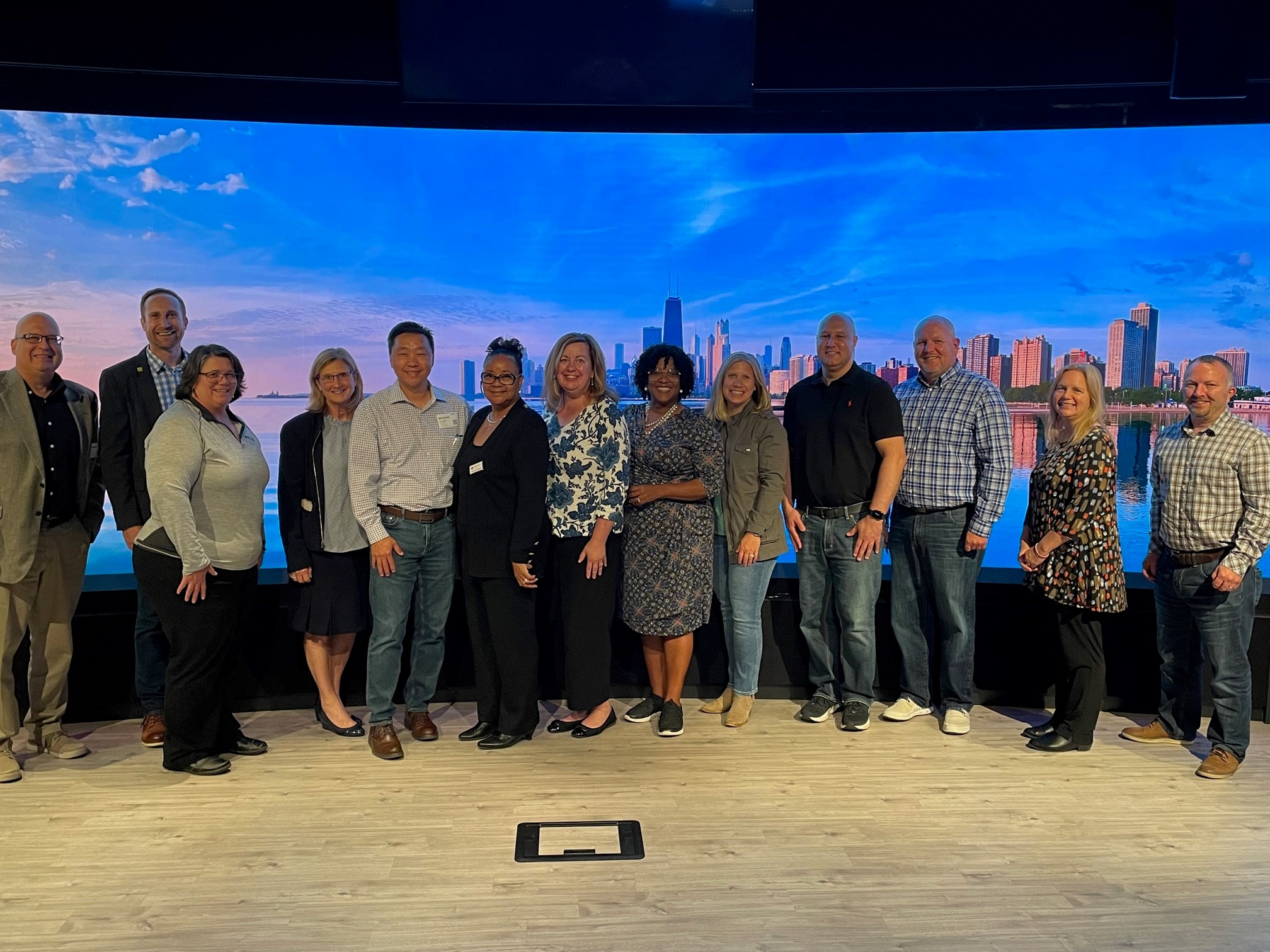July 2023 Tech Upload
NEW Digital News

Microsoft Tour
On June 16, a few NEW Digital Alliance investors were able to tag along with the NEW Manufacturing Alliance for a tour of Microsoft’s Chicago Technology Center. This location helps companies be innovative and create solutions to problems in the areas of manufacturing, health care and retail industries. They offer support for companies digital transformation journey in six core offerings:
- Envisioning workshop
- Strategy briefing
- Architecture design session
- Rapid prototype
- Hands-on lab
- Hackathon
How to E-Recycle Military or Government Equipment
If you are a government or military contractor, then you already know that you have a lot of hoops to jump through and one of them is ITAR. When it comes to how to e-recycling military and government equipment, you need an ITAR-registered e-recycler. In truth, even if you are not working with the military or the government, you may still need or at least want to work with an ITAR-registered facility.
Why Do You Need an ITAR Registered E-Recycler?
ITAR is essential for any business or entity that works as a government or military contractor and is required in other industries as well. Most who work in those industries already know, but for those that are concerned about ITAR, we’ve put together some information for you below.
What is ITAR?
ITAR is an acronym, and as you may have already guessed, it is a government acronym. The government does love its acronyms, don’t they? ITAR stands for International Traffic in Arms Regulations and it’s been around since 1976.
It’s also worth mentioning that ITAR is not a certification. Anyone that calls it a certification does not know what they are talking about. ITAR is a set of procedures that should be followed by any ITAR-registered entity that is performing an ITAR-compliant service. This means you are not looking for an ITAR certification but rather an ITAR-registered vendor, e-recycler, or asset disposal service to work with.
Essentially this regulation is designed to restrict and control the export of defense and military-related technologies in an effort to safeguard U.S. national security. Now, you may think, if you don’t have arms like bombs or guns, then this doesn’t apply to you, but that’s not actually the case.
How Does ITAR Define Military-Related?
Honestly, the term military-related technologies can be applied pretty broadly, but here are a few of the big ones that may not be as obvious as guns, missiles, and tanks:
- Military Protective Personnel Equipment
- Military Electronics
- Materials and Miscellaneous Equipment
- Classified Articles
- Articles, Technical Data, and Defensive Services Not Otherwise Enumerated
All of those are taken directly from the regulations themselves and you can see how they can be fairly ambiguous and left up to interpretation. Something as simple as a mundane processor that is built to regulate the HVAC on a military transport truck may fall under ITAR.
For this reason, it is recommended that anyone that produces materials or equipment for government defense or the military, strictly follow ITAR, and that means all your vendors need to follow ITAR as well and only work with ITAR-registered entities.
Benefits of Working With an ITAR-Registered E-Recycler
Even if you are not working with the government, it might be a good idea to work with an ITAR-registered vendor and request ITAR-compliant asset disposal. Following ITAR-established procedures ensures a higher level of security, greater protection against a data breach, and provides peace of mind. For this reason, there are several major companies that only work with ITAR-registered vendors despite not being required to under ITAR.
Jewelers Mutual® Group CIO Named to 2024 Constellation Research Business Transformation 150
John Kreul recognized for his exceptional leadership in driving the company’s digital future
John Kreul 1Jewelers Mutual® Group, the insurance and business solutions provider dedicated to the jewelry industry since 1913, announced its Chief Information Officer, John Kreul, has been recognized by Constellation Research on its 2024 Business Transformation 150, an elite list of executives leading business transformation efforts around the globe.
Since assuming the role of CIO in November of 2021, John Kreul has been working to set the vision for Jewelers Mutual’s future by embracing technology-led innovations that enhance the customer experience. With over 30 years of expertise in the technology space, he champions a progressive company culture that fosters curiosity to reimagine how to meet and exceed customers’ evolving needs. Kreul’s digital mindset has propelled the company forward with continued investments in technology that empower jewelers, simplify operations, strengthen relationships and improve the overall customer journey. As a change agent who is driving digital solutions and industry-wide progress, Kreul is helping position Jewelers Mutual as an innovation leader.
“I am immensely grateful to be recognized for my role in steering our company’s digital future. This recognition truly reflects the hard work and collective dedication of our talented team,” said Kreul. “Together, we will continue to push the boundaries of what’s possible and shape a transformative digital landscape for our organization.”
The power of generative artificial intelligence has driven sweeping changes across industries in a remarkably short timeframe. Digital leaders have been at the forefront, leveraging these technologies to accelerate progress and enhance their impact. As a result, many have assumed expanded roles and taken their place among the executive leadership team, with some even rising to the position of CEO within the past year. Notably, this year’s BT150 nomination process highlights the increasing importance of digital leaders who prioritize stakeholder and shareholder interests, embodying the principles they champion.
“In the year of extreme efficiency, these organizations and their leaders have balanced the need for business transformation and optimization,” noted R “Ray” Wang, founder and CEO at Constellation Research. “The BT150 are the most resilient, skilled, and successful leaders in leading large-scale change. We’re excited to see a diversity of industries, projects, and roles in this year’s winners.”

Constellation BT150 FINAL 02 1“The BT150 this year reflects the momentous trends in the market, from the challenges of navigating economic turmoil to the surge in interest in artificial intelligence,” said Dion Hinchcliffe, VP and principal analyst at Constellation Research. “These digital leaders are stand-out exemplars of innovation, an effective digital mindset, and the ability to guide organizations through uncertain times.”
Nominations from peers, industry influencers, technology vendors and analysts powered the six-month selection process. Each executive on the list demonstrates an understanding of how the business environment is transforming in response to digital and exponential technologies, and these leaders are actively preparing their companies to excel during and after the transformation.
Proactively Managing Cyber Threats
By Brian Leslie
Faith Technologies
It seems that every week there are news stories about one company being attacked by Ransomware, another hit with Business Email Compromise, and yet another that has been phished. Cybercrime continues to grow, and the impact on businesses is tremendous. Recovering from an attack or breach can be costly. First you have forensic and investigation activities which often include crisis management. Then we move onto costs associated with notifying data subjects and third parties. Business disruption costs also occur from downtime, let alone the cost of potentially losing current customers and new ones.
So how can you stay on top of cyber threats and cybercrime? While there are many activities a company needs to do, Managed Detection and Response (MDR) can be an appropriate place to start.
MDR is a service that allows for a skilled partner to act as extension of your own cyber team. They provide a dedicated Security Operations Center (SOC) to actively monitor your systems 24x7x365. Their primary goals are to detect threats, analyze, investigate and actively respond to them with the intention to thwart them in their tracks.
With the prevalence of ongoing attacks, having a MDR can be highly advantageous. Here are three benefits of leveraging an MDR service.
- Improve Security Maturity and Effectiveness – MDR providers will leverage people, processes and technology to identify threats. Let’s start with a concept called Indicators of Compromise (IOC). IOCs refer to activity within your network that can be defined as unusual activity. Think of these as potential red flags. An example is a user who lives in North America. Now imagine their corporate account is continuously connecting to your network from another continent. In this scenario it could either be a cyber criminal or maybe just a team member who is traveling. Regardless, this could be defined as an IOC which needs to be investigated. These types of red flags can often go unnoticed without the right technology, processes and people who are trained and dedicated to spot them. This is where both maturity and effectiveness come in. MDR teams will greatly improve your mean time to detect and your mean time to remediate threats and vulnerabilities.
- Full-Time Coverage with Active Response – With the increased sophistication of cyber criminals, it’s important to place emphasis on quick response. Above I mentioned mean time to detect and mean time to remediate. The bad guys don’t always sleep, so how will you know about that high priority IOC at 2 a.m.? This is where 24x7x365 coverage comes into play. The SOC analysts can act as an extension of your security team and tailor services to your industry and business. Having dedicated SOC analysts performing forensic analysis to validate alerts and eliminate false positives keeps your existing team focused on business priorities. SOC teams can act independently and also get in touch with your internal teams to partner when needed.
- Demonstrating Accountability and Trust – As cybercrime continues to grow and the bad guys press on, we need to hold ourselves accountable. Companies are obligated to put cyber capabilities in place to detect potential compromise and perform due diligence in acting upon that risk. While no company, big or small, is immune to an incident, we must always be responsible stewards of our systems. We owe it to our customers, who have high expectations of data protection. We owe it to our employees, who rely on us to protect their personal employee information. We owe it to our company, to protect the health of the organization.
Many strategies exist to be able to detect cyber threats. Whether you leverage an in-house model or a combined approach with a partner, there are benefits. If you are not familiar with a Managed Detection and Response model, I encourage you to check it out and see if it’s right for your company.
Are your cyber defenses ready for AI?
April 26, 2023
By Jeff Olejnik
ChatGPT can prepare comprehensive reports within seconds, eliminating hours of research and writing. And it’s often hard to distinguish between human-made and bot-made work. The potential applications are exhilarating. And terrifying — especially when you start thinking about cybersecurity.
Old tools in new hands
Artificial intelligence (AI) and machine learning aren’t new tools. Companies have used AI for years to make smarter and faster decisions about everything from inventory to finances. Security tools use AI to classify behaviors as “normal” or “unusual,” and to quickly flag potential threats for investigation.
But now, the power of generative AI is accessible to more people. In the wrong hands, it can be used for nefarious purposes. It took ChatGPT about 40 seconds to come up with five ways it could be used to carry out cyberattacks. When asked “How could cybercriminals use ChatGPT?” it suggested:
- Social engineering: Cybercriminals can use ChatGPT to craft convincing messages that appear to be from a legitimate source, such as a bank or a government agency, and use them to trick people into divulging sensitive information such as login credentials or personal identification details.
- Phishing: ChatGPT can be used to generate sophisticated phishing emails that trick recipients into clicking on malicious links or downloading malware.
- Spamming: Cybercriminals can use ChatGPT to generate large volumes of spam messages that are difficult to distinguish from legitimate communications.
- Malware attacks: ChatGPT can be used to generate code that can be used to exploit vulnerabilities in systems and launch malware attacks.
- Fraud: Cybercriminals can use ChatGPT to generate fake documents, such as invoices or receipts, which can be used in fraudulent transactions.
The creators of ChatGPT and similar technologies acknowledge there are potential security risks and have implemented some safeguards to respond negatively to questions about conducting illegal activity.
But crafty individuals many times can bypass the negative response by simply rephrasing the question. In addition, there are no current regulatory boundaries around how the tools are used. That means it’s up to companies to predict and mitigate threats.
AI will exponentially increase the velocity and sophistication of cyberattacks, which could make phishing and social engineering schemes even more convincing.
No wonder CTOs are losing sleep.
Are you ready to protect yourself?
Modern cybersecurity requires a layered approach. Companies need a combination of preventive, detective and responsive capabilities to thwart criminals.
In this era of AI, companies also need two essential cybersecurity capabilities:
- AI-enabled detection: It’s time to fight fire with fire. Companies need 24/7, AI-enabled security monitoring to spot indicators of compromise. AI can analyze traffic patterns and identify suspicious activities such as large data transfers or atypical login attempts.
For some companies, building out the tools and staffing for 24/7 monitoring isn’t practical. But they can’t afford the fallout from a cyberattack, either. In these situations, companies can get affordable security capabilities through a service provider.
Regional News
Wisconsin secures $1 billion to bridge digital divide and expand internet access
June 26, 2023
By Ashley Kaster, FOX 11 News
(WLUK) — The state of Wisconsin will receive $1.05 billion to connect unserved homes and businesses to the internet.
The federal investment comes from the $42.5 billion Broadband Equity, Access and Deployment program, or BEAD, which is included in the infrastructure bill signed in 2021 by President Joe Biden.
“No matter where you live in the state, you deserve access to reliable high-speed broadband, and these resources will help us do that. This investment will help close the digital divide so Wisconsinites can fully participate in the economy, kids can get the education they deserve, and families can connect with people across the world. This is an investment in our Wisconsin families. This is an investment in our Made in Wisconsin economy. And this is an investment in our future – and I am proud to help deliver it,” said U.S. Senator Tammy Baldwin.
Making tech jobs more accessible to girls and students of color
June 23, 2023
Detroit Today
STEAM Connection founder Danielle Boyer discussed making tech jobs more accessible for Black and Brown Americans.
Indigenous Americans are often excluded from tech, math and engineering spaces.
According to the STEAM Connection, just nine percent of Indigenous households have personal computers, and even fewer have internet access. This group makes up only 0.4% of the engineering workforce.
America’s Indigenous population isn’t terribly large, but these numbers are also reflective of more insidious trends — those of colonization, racism and historical exclusion.
There are organizations and individuals who are working to include Indigenous Americans, women and people of color in the fields of science and technology.
The next big thing in coding bootcamps in 2023: Apprenticeships
May 23, 2023
By Sam Becker
While it may seem like coding bootcamps have always been a part of the tech economy’s source code, they are actually a relatively new addition to the education sphere. As alternatives to traditional degree programs, bootcamps are well on their way to becoming a $1.2 billion industry by 2026, according to estimates by Technavio.
Bootcamps allow students to learn tech skills (often coding or programming) over an intense, short period of time—and then immediately get plugged into the tech job circuit. They’re often viewed as a relatively quick way to make a career change, upskill, or land a high-paying job.
There are many of them, too, offered by both public colleges and universities, and private organizations in tech-heavy cities like New York City, Seattle, and San Francisco. In short, a big bootcamp circuit has developed over the years, even though each individual bootcamp provider varies in terms of course offerings, price, and the career possibilities that open up to graduates.
Meanwhile, fluctuations in the economy—caused by the pandemic, layoffs in the tech sector, and the advent of tools powered by artificial intelligence (A.I.)—have added further complexity to the bootcamp space. As such, many coding bootcamps, and the bootcamp model more broadly, have evolved and will continue to do so. In fact, some experts say the next big shift is already underway.
States Scramble To Fill The Tech Talent Shortage
June 21, 2023
By Jamie Merisotis
As states across the country work to grow their percentage of learners with education beyond high school—48 states have set such goals—a parallel effort is underway.
Increasing the number of tech jobs—in all industries—is emerging as a national imperative.
Despite what you’re reading about layoffs in tech, the number of jobs is outpacing the ability to find, hire, and retain qualified talent in many parts of the country. Employers in several states are gobbling up the talent let go by big tech companies but say that will not be enough to meet the demand.
There is a growing urgency to address the shortage.
For example in Indiana, TechPoint, a nonprofit, industry-led growth accelerator, has set a goal to create 41,000 new tech jobs in the state by 2030. TechPoint’s Mission41K is a collaborative effort of business and education leaders who are drawing attention to one of the biggest issues facing tech employers today: finding, hiring, and retaining qualified talent.
At the heart of the initiative is the need for training and credentials beyond the high school diploma.
Microsoft Launches New AI Skills Training and Resources as part of Skill for Jobs Initiative
June 28, 2023
By Kate Behncken
AI offers tremendous potential to empower workers around the world – but only if everyone, everywhere has the skills to use it. It’s little surprise that, according to the World Economic Forum, AI skills represent the third-highest priority for companies’ training strategies, right alongside analytical and creative thinking.
To begin addressing this need, today we are launching a new AI Skills Initiative to help people and communities around the world learn how to harness the power of AI. The Microsoft AI Skills Initiative includes new, free coursework developed with LinkedIn, including the first Professional Certificate on Generative AI in the online learning market; a new open global grant challenge in coordination with data.org to uncover new ways of training workers on generative AI; and greater access to free digital learning events and resources for everyone to improve their AI fluency.
As noted in Microsoft’s recent Work Trend Index, AI is uniquely poised to create a whole new way of working just as the pace of information work is outpacing our ability to keep up. A whopping 62% of survey respondents said they struggle with too much time spent searching for information in their workday. And while 49% of people say they’re worried AI will replace their jobs, even more—70%—would delegate as much work as possible to AI to lessen their workloads. To that end, our new AI Skills Initiative aims to help workers around the world stay ahead of emerging skills gaps and take advantage of these new technologies.







